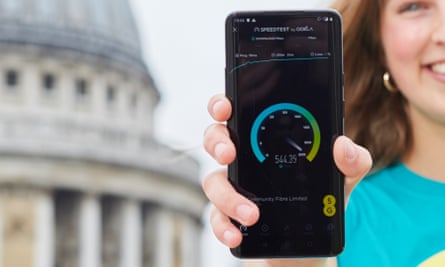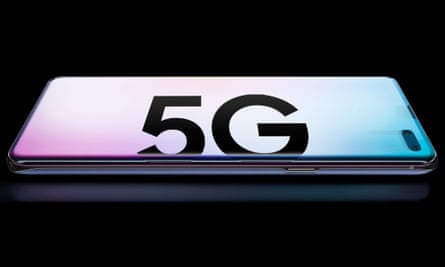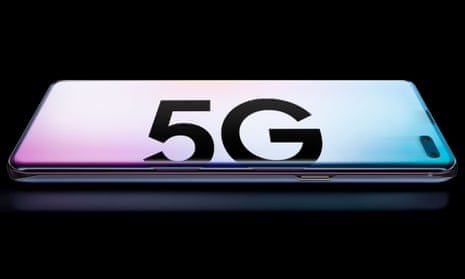After years of hype, the switch will be flicked on the UK’s first 5G network on 30 May. Network operator EE, part of BT, will be first out of the blocks. According to telecoms and phone firms the benefits of 5G are obvious – but what exactly is it, how can you get it and how much is it going to cost?
What is 5G?
It is the next generation mobile phone network and it promises much higher connection speeds, lower latency (response times) and to be more reliable than the creaking 4G networks we have now.
What will it do?

It will be much faster, with download speeds 5-10 times quicker than 4G to start with, meaning a movie will download in seconds rather than minutes. Over the next few years it should become even faster, as the technology matures. It will also have lower latency, the time it takes for something to happen: tap a link and the download will start faster.
But perhaps the most important thing 5G will immediately do for users is increase the carrying capacity of the masts, meaning more people can connect at the same time.
Who needs it?
Early adopters, anyone looking for raw speed and people who live in dense urban areas fed up with current 4G problems, such as when you appear to have a full signal but nothing happens when you tap a link.
“5G is like getting a seat on a packed train, or a lane of the motorway all to yourself,” said EE’s CEO, Marc Allera.
When can I get it?
EE will be the first the launch a 5G network in the UK on 30 May. Vodafone is following on 3 July. O2 and Three expect to launch their networks later this year.
The UK is one of the first countries in Europe to start rolling out 5G but Switzerland is the furthest along with 227 areas, according to the tracking firm Ookla. There are also limited areas in Finland, Italy, Poland and Spain.
5G networks are also up and running in parts of the US, Argentina, South Africa, Qatar, United Arab Emirates, China, South Korea and Australia.
Where can I get it?
EE is launching its 5G network in the busiest areas of Belfast, Birmingham, Cardiff, Edinburgh, London and Manchester. Later this year other areas will join, in Bristol, Coventry, Glasgow, Hull, Leeds, Leicester, Liverpool, Newcastle, Nottingham and Sheffield.
Vodafone is kicking off its 5G network in parts of Birmingham, Bristol, Cardiff, Glasgow, Manchester, Liverpool and London. Later this year it will flick the switch in Birkenhead, Blackpool, Bournemouth, Guildford, Newbury, Portsmouth, Plymouth, Reading, Southampton, Stoke-on-Trent, Warrington and Wolverhampton.
How much will it cost?
On EE: 5G costs £5 more than 4G, which means from £54 per month for 24 months with 10GB of data and a phone (£170 up front) or from £32 per month for 20GB for sim-only for 12 months.
On Vodafone: 5G plans cost the same as 4G plans, starting at £50 per month for 24 months with 5GB of data and a phone (£99 up front). The network does not offer sim-only 5G plans.
Do I need a new phone?

Yes. To access a 5G network you need a smartphone with a 5G modem. There are a handful now on sale, including Samsung’s Galaxy S10 5G, the OnePlus 7 Pro 5G, Xiaomi’s Mi Mix 3 5G, LG’s V50, Oppo Reno 5G and a few others.
Most 5G phones are top-of-the-line and therefore expensive. They are also big – with the largest screens.
How will I know I’m on 5G?
Simply put, you’ll see a “5G” icon in your smartphone’s status bar. But things are a little more complicated in the beginning. For the next couple of years, the 4G network is going to still be used for most things other than downloading data even when connected to 5G, including calls and managing connections.
It won’t be until 2022 that 5G will take over all of these “core network” functions and you will no longer drop down to the 4G network to make a call. A similar situation happened in the initial phases of the 3G to 4G transition.
But I’m already seeing the 5G icon on my old phone?
Some mobile networks in the US have decided to show their customers a “5G E” symbol on their old phones when in fact they are only connected to a variant of 4G.
Is all 5G equal?
No. As with 4G before it, there are a range of frequencies on which 5G can operate. Unlike 4G there’s a radical difference between them.
Across the UK the 5G networks will initially be launched on sub-6GHz frequencies, primarily between 3.4 and 3.6GHz (4G operates between 800MHz and 2.6GHz in the UK).
The higher the frequency, the higher the carrying capacity - and therefore the speed of the network.
But the higher the frequency the smaller the distance that can be covered effectively and the less well the radio waves can penetrate objects. So buildings, cars, people and any other obstacles can block the signal.
What will 5G enable in the future?
5G promises seamless, super fast connectivity for practically anything, which will enable all sorts of different functions to flourish but likely not until after 2023.
Some of the most common expected applications revolve around connected infrastructure, turning everything from lamp-posts and roads, to bins and bike racks into smart objects. In other words, the “internet of things”.
The most obvious and exciting revolution that 5G will help is in transport. With ubiquitous, ultra-low-latency connections it means cars, buses and roads could all talk to each other in real time, warning drivers of incidents, patches of black ice or removing the need for the driver at all, in the world of self-driving cars.
Other predicted services include all manner of robots, augmented reality, mobile gaming and of course super-fast video downloads.
